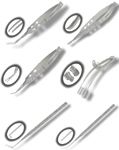Article
Disposable instruments option for surgeons
Irvine, CA?A new line of stainless steel, disposable instruments for anterior segment surgery from Rhein Medical would be cost effective in privately operated surgical centers or other settings where they could be reused a number of times, due to a combination of high quality and moderate cost, according to a surgeon who has tried the new products.

According to Roger F. Steinert, MD, director of refractive, cornea, and cataract surgery, University of California Irvine Medical Center, Irvine, CA, the mental image of disposable instruments is of crudeness, inferiority, cheap materials, and poor quality.

However, because of the low cost, surgeons can still reduce the cost per case by throwing an instrument away after 20 uses instead of using a more expensive tool, Dr. Steinert said.
The Rhein Eco's instruments cost about 10% as much as conventional, high-quality, multi-use instruments on the market. In fact, the name "Eco's" is derived from their market niche as an economical choice, Bee said, while it also suggests repeated use by being a play on the word "echoes."
The instruments are packaged sterile, six per box, in double Tyvek pouches, and are ready for immediate use. The line includes capsulorhexis, corneal, and tying forceps; needle holders; scissors; manipulators; choppers; dilators and rotators; and speculums.
"The main thing about them was that they all worked beautifully," Dr. Steinert said. "The ones that impressed me the most were the tying forceps and the tying platform on the 1 × 2 forceps because they were perfect with very fine, delicate tips."
The new instruments also solve problems surrounding dropped, damaged, or contaminated instruments, because the surgeon can simply open another package rather than wait for a replacement to be found or for resterilization, Dr. Steinert said.
Surgeons practicing in private surgical centers who have the latitude to resterilize and reuse the instruments are a primary market, because instruments labeled as single-use cannot be reused in most publicly funded hospitals or clinics, he said. As single-use instruments, the Rhein Eco's would be less cost effective.
The Rhein Eco's fill a niche for surgeons looking for ways to lower costs per case and also reduce the expense of repairing or replacing damaged instruments, Bee said.
"If the quality is acceptable, they are definitely going to get their costs way down."
He added that Rhein has been able to set a low price for the new instrument line through a special manufacturing technique that substantially lowers the cost of production while maintaining quality.
Dr. Steinert suggested that surgeons approach the Rhein Eco's line with an open mind and give them a try.
"If they like them and agree with my feeling, which is that there is no compromise in the basic quality of the instrument itself, then they can do an analysis of the uses they can get out of them and whether they would save money compared with their current instruments," he said.
Newsletter
Don’t miss out—get Ophthalmology Times updates on the latest clinical advancements and expert interviews, straight to your inbox.




